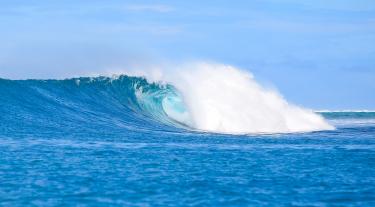Publication date July 2011
Information was correct at the time of publication
The potential for wave and tidal stream to make a material contribution to the UK's energy mix is well recognised, and is reflected in the level of UK activity. As the industry moves from full-scale prototype stage to first arrays, the key challenge facing the marine energy industry is lowering the cost of energy generation.
Wave and tidal stream energy: the Marine Energy Accelerator
The Marine Energy Accelerator, which ran from 2007 to 2010 was designed and managed by Carbon Trust and funded by DECC. The programme focussed on reducing the cost of energy from wave and tidal stream technologies.
The final report Accelerating Marine Energy CTC797 (PDF) was published in July 2011 and contains case studies of various Marine Energy Accelerator projects. It also includes analysis of the UK wave and tidal stream resource, and identifies pathways towards continued cost reduction in the industry, and towards full exploitation of the UK resource which has the potential to generate about 15% - 20% of the UK's electricity.
What were the aims of the Marine Energy Accelerator?
The Marine Energy Accelerator was aimed at helping achieve marine energy cost reduction through 3 distinct strands, as follows:
- Next generation concepts: Developing new device concepts that could significantly marine energy lower costs.
- Device components: Research into lowering costs of specific components in existing marine energy devices.
- Installation, operation & maintenance: Developing strategies on how to improve ways marine energy devices can be installed, operated and maintained at a lower cost.
The Marine Energy Accelerator invested £3.5m and operated until the end of 2010.
What types of organisations were involved?
During the accelerator, we worked with:
- Device developers
- Component technology manufacturers
- Engineering consultants/contractors
- Academic research groups
Resource and economics assessments
As supporting activity for the MEA the Carbon Trust has also investigated the UK Resource for both tidal and wave energy. The tidal energy report is an update to work previously published in 2005, while the wave energy resource assessment is new.
Tidal
The UK Tidal Current Resource and Economic Assessment CTC799 (PDF) provides estimates based on an updated hydrodynamic methodology for: technical resource, practical resource, and cost of energy at all UK sites with sufficient energy density and depth.
The tidal resource and costs assessment has been supported by The Crown Estate, with supporting hydrodynamic theory work (Appendix C) also supported by the Juice fund.
The report also investigates the variations in cost of exploiting the resource across the sites. This leads to a conclusion that tidal energy devices are needed that can cope with difficult and deep waters such as those in the Pentland Firth where much of the resource is located.
Wave
The UK Wave energy resource report CTC816 (PDF) investigates the 'total', 'technical' and 'practical' wave energy resource. This study predicts where wave energy project developers will site their arrays, showing that the most attractive sites for offshore devices are tens of kilometres offshore. The impact of practical constraints such as space for shipping lanes and the impact on fishing are taken into consideration.


